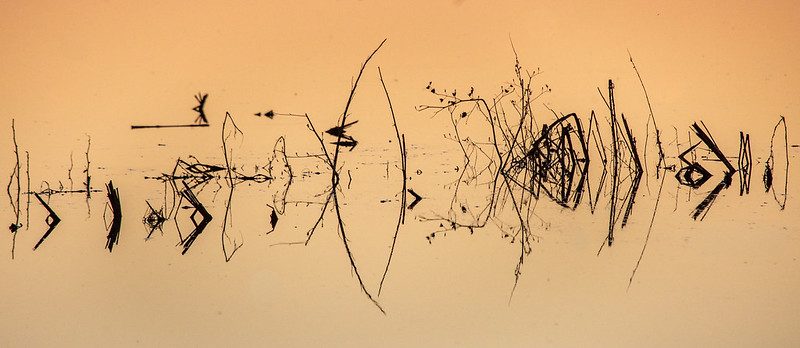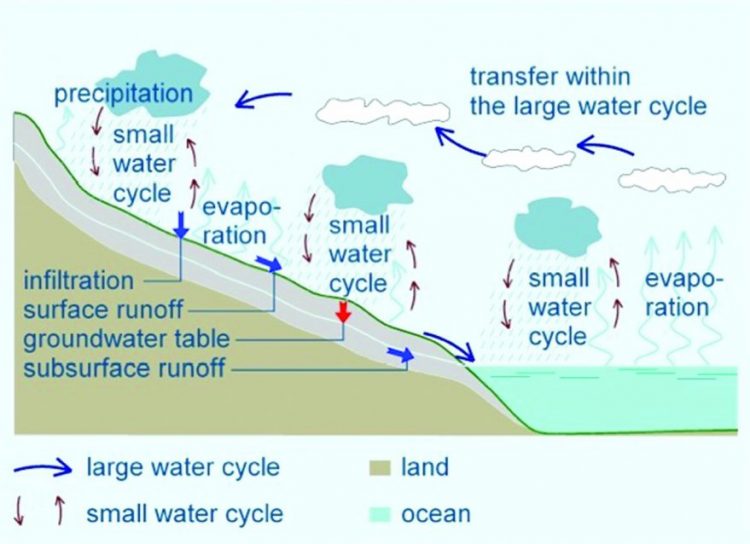The Small Water Cycle & Global Warming

By Christopher Haines.
WHEN JIMMY CARTER ASKED scientist Charles Keeling for advice in 1978 on what the government should do about climate change, Keeling said that the problem was far too complicated for people to understand, so focus on greenhouse emissions. Since then, reducing greenhouse emissions has been the principal focus for those interested in reducing their environmental impact. While greenhouse emissions must be reduced, new science is showing us that expanding our focus to restoring natural ecosystems could ameliorate the effects of rising greenhouse gases on global temperature increases.
While greenhouse emissions do increase the planet’s energy load, that energy does not need to cause temperature rise (sensible heat). When solar energy falls on moist surfaces or living plants, it produces evaporation or evapotranspiration (latent heat), increasing humidity, not temperature.
It is this hydrologic cooling that forests and other living plants create that prompted David Ellison and 22 other researchers to state, “Forests and trees must be recognized as prime regulators within the water, energy and carbon cycles….” They call for a “reversal of paradigms, from a carbon-centric (greenhouse) model to one that treats the hydrologic and climate-cooling effects of trees and forests as the first order of priority.”

The earth’s rotation creates a lateral circulation of moisture known as the “large water cycle.” Evaporation from the oceans accounts for 86% of the atmospheric moisture, but 26% of that falls onto the land. Therefore, the land contributes 14% of the evaporation but receives nearly twice that much back as rain or snow. Thus, the world’s rivers run to the sea, yet the sea level did not rise as it is rising now.
A “small water cycle,” a vertical generator of mild, local weather, operates within each watershed. The critical term here is vertical. Small water cycles need to recycle water within the watershed in order to maintain the local ecology, as moist environments attract more moisture and dry environments repel it. Humans violate this law of nature by draining away “waste-water.” Each turn in the affected water cycle slightly decreases the amount of water that cycles within it.
But unnatural drainage is not the only problem. Soil naturally holds water in relation to the amount of organic matter it contains. An increase of one percent of carbon in soil will increase the water-holding capacity by 20,000 gallons per acre. As industrial agriculture, with tillage and chemicals, degrades the soil we inherited to “dirt,” water drains from the land, no longer able to hold it. Studies have documented whole countries drying out over decades due to this man-made manipulation.Besides holding-capacity, soil health also has dramatic impacts on percolation rates, determining how much rainwater soaks into the ground, affecting flooding and how quickly it runs off, causing erosion.
Desertification shifts rain patterns, decreasing rainfall on lower elevations and increasing it in higher elevations. This breaks the small water cycle and allows the more violent large water cycle to predominate, leading to more severe storms with flooding and associated damage, but blinds residents to the fact that their country is undergoing desertification.
The human settlements that date back to the dawn of the agricultural era, such as those in the Middle East, northern Africa, India, and China, are now largely deserts due to deforestation, agriculture and urbanization. Despite the evidence, we have not rethought our impact on climate systems. These common practices decrease evapotranspiration, which causes increased temperatures (sensible heat) and increased temperature divergence.
Human actions have created deserts, but we must look beyond greenhouse emissions to a systemic understanding of biological systems to begin the healing.
Sources:
Brown, G, (2018). The Farm as an Ecosystem. Worcester MA: Worcester State University.
Ellison D, Morris C, Locatelli B et al. (2017). Trees, Forests and Water: Cool Insights for a Hot World. Global Environmental Change 43: 51-61.
Griffith, B, (2001). The Gardens of their Dreams: Desertification and Culture in World History. Halifax, Nova Scotia: Fernwood Publishing.
Jehne W, (2015). The Natural History of Water on Earth. Medford, MA: Tufts University:.
Kravcik M, Pokorny J, Kohutiar J et al. (2008) Water for the Recovery of the Climate: A New Water Paradigm. Typopress-publishing House.

